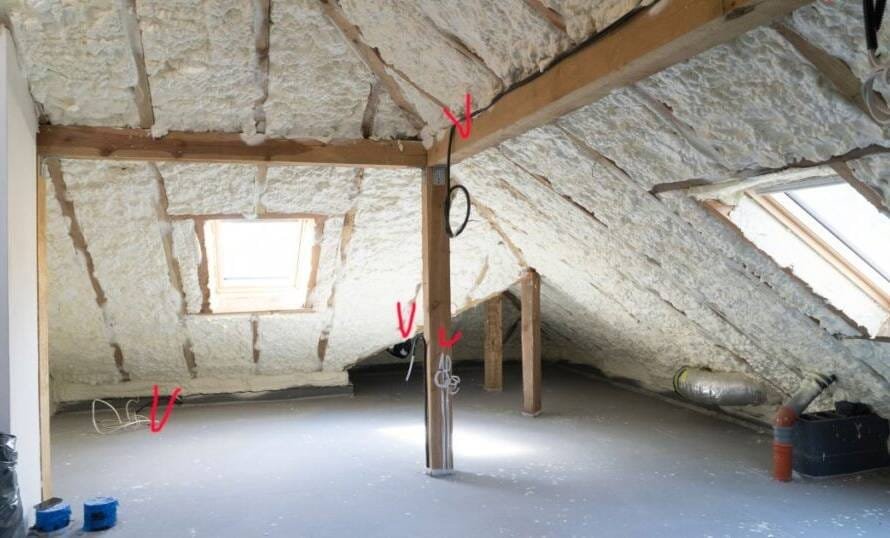Did you know that up to 25% of your home’s heat can escape through an poorly insulated attic? This staggering statistic highlights a critical issue facing many homeowners today. As energy costs continue to rise and environmental concerns grow, understanding and implementing effective attic insulation has never been more important.
In this post, we’ll delve into the fascinating world of heat transfer and explore how different insulation materials work to keep your home comfortable while reducing energy waste. By understanding the principles behind effective insulation, you’ll be equipped to make informed decisions about your home’s energy efficiency.
Proper attic insulation is more than just a way to lower your utility bills – it’s a crucial component in creating a more sustainable and comfortable living environment. Whether you’re looking to reduce your carbon footprint, save money, or simply enjoy a cozier home, mastering the basics of attic insulation is an essential step. Let’s explore how this often-overlooked aspect of home maintenance can have a significant impact on your daily life and the planet.
Understanding Heat Transfer

To truly appreciate the importance of attic insulation, we must first understand the fundamental principles of heat transfer. Heat, always seeking equilibrium, moves from warmer areas to cooler ones through three main mechanisms:
- Conduction: This is the transfer of heat through direct contact between particles of matter. In your home, conduction occurs when heat moves through solid materials like walls, roofs, and floors. For example, on a cold day, you might feel the chill of a metal doorknob – that’s conduction in action.
- Convection: This process involves the transfer of heat through the movement of liquids and gases. In your home, convection is responsible for the warm air rising to the ceiling and the cool air sinking to the floor. It’s also why you feel a draft near a poorly sealed window.
- Radiation: Unlike conduction and convection, radiation doesn’t require a medium to transfer heat. Instead, it travels in the form of electromagnetic waves. The warmth you feel from sunlight or a fireplace is heat transfer through radiation.
Examples of these types of heat transfer are all around us. When you stir a hot cup of coffee, you’re using convection to distribute heat evenly. Touch a warm stovetop, and you’ll experience conduction. Stand near a campfire, and you’ll feel the radiant heat on your skin.
How Heat Transfer Affects Your Home
Understanding these principles is crucial because they directly impact your home’s energy efficiency and comfort:
Winter Heat Loss: During cold months, your heated indoor air naturally wants to escape to the cooler outdoors. This occurs through all three heat transfer methods:
- Conduction through walls and roofs
- Convection through gaps and cracks
- Radiation through windows and thin barriers
The attic is particularly vulnerable to heat loss. As warm air rises, it can easily escape through an poorly insulated attic, forcing your heating system to work harder.
Summer Heat Gain: In warmer months, the process reverses. Heat from the outside tries to enter your cool home:
- The sun’s radiant heat warms your roof and walls
- This heat conducts through to the interior
- Warm air enters through gaps and openings
Your attic, which can reach extremely high temperatures in summer, becomes a major source of heat gain if not properly insulated.
Impact on Energy Bills: The constant battle against heat transfer can significantly impact your energy costs. In winter, heat loss means your heating system must work overtime to maintain a comfortable temperature. In summer, heat gain forces your air conditioning to run more frequently. Both scenarios lead to higher energy consumption and, consequently, higher utility bills.
By understanding these principles of heat transfer, you can better appreciate the role of effective attic insulation in creating an energy-efficient home. In the next section, we’ll explore how different insulation materials work to combat these heat transfer processes and keep your home comfortable year-round.
How Insulation Works

Now that we understand the basics of heat transfer, let’s explore how insulation combats these processes to keep your home comfortable and energy-efficient.
Blocking Conduction: Insulation materials are designed to have low thermal conductivity, meaning they don’t easily allow heat to pass through them. They achieve this by trapping tiny pockets of air within their structure. Since air is a poor conductor of heat, these pockets create a barrier that slows down heat transfer through your walls and roof. The thicker the insulation, the more effective it is at reducing conduction.
Reducing Convection: Insulation also plays a crucial role in minimizing air movement within your home’s structure. By filling spaces in walls, attics, and floors, insulation reduces the air currents that can carry heat away in winter or bring it in during summer. This is particularly important in attics, where convection can lead to significant heat loss if left unchecked.
Minimizing Radiation: While traditional insulation primarily addresses conduction and convection, specialized reflective insulation targets radiant heat transfer. These materials, often with a shiny foil surface, reflect radiant heat back to its source, whether that’s the sun’s heat in summer or your home’s warmth in winter.
Types of Insulation Materials
Different insulation materials offer varying benefits and are suited to different applications. Here’s an overview of some common types:
Fiberglass:
- Composition and installation: Made from fine glass fibers, fiberglass insulation comes in batts, rolls, or loose-fill form. It’s relatively easy to install and is one of the most common insulation materials.
- Effectiveness in different climates: Fiberglass performs well in both hot and cold climates, making it versatile for various regions. However, its effectiveness can decrease if it gets wet, so proper moisture control is essential.
Cellulose:
- Eco-friendliness and insulation properties: Made primarily from recycled paper products, cellulose is an environmentally friendly option. It’s treated with fire retardants and has excellent insulating properties.
- Ideal usage scenarios: Cellulose is particularly effective for retrofitting existing homes as it can be blown into wall cavities and attics without major renovations. It’s also good at filling irregular spaces.
Spray Foam:
- Application process and benefits: Spray foam is applied as a liquid that expands to fill gaps and cracks. It comes in two types: open-cell (lighter, less expensive) and closed-cell (denser, more effective).
- Energy efficiency performance: Spray foam offers excellent air sealing properties in addition to insulation, making it highly effective at reducing both conduction and convection heat transfer.
Reflective or Radiant Barriers:
- How they work: These materials, typically foil-faced, work by reflecting radiant heat rather than absorbing it. They’re particularly effective in hot climates where they can reflect the sun’s heat away from the home.
- Best practices for use: Radiant barriers are most effective when installed in attics, facing an air space. They’re often used in conjunction with other insulation types for maximum efficiency.
Each of these insulation types has its own strengths and ideal applications. The best choice for your home will depend on factors such as your local climate, the area you’re insulating, your budget, and your energy efficiency goals. In the next section, we’ll discuss how to determine the right insulation solution for your specific needs.
Comparing Insulation Materials

R-Value Explanation: When comparing insulation materials, one of the most important factors to consider is the R-value. The R-value measures a material’s thermal resistance – its ability to resist heat flow. The higher the R-value, the more effective the insulation.
R-values are typically given per inch of material thickness. It’s important to note that doubling the thickness of insulation doesn’t necessarily double its R-value, but it does increase its effectiveness. The Department of Energy provides recommendations for R-values based on your geographic location and the part of the house being insulated.
Material Comparison: Let’s compare the R-values and effectiveness of common insulation materials:
- Fiberglass:
- R-value: 2.2 to 2.7 per inch
- Effectiveness: Good overall performance, widely used due to its cost-effectiveness
- Cellulose:
- R-value: 3.1 to 3.8 per inch
- Effectiveness: Slightly better than fiberglass, with good sound-dampening properties
- Spray Foam:
- Open-cell: R-value of about 3.6 per inch
- Closed-cell: R-value of 6.0 to 6.5 per inch
- Effectiveness: Excellent air-sealing properties in addition to high R-values
- Reflective Barriers:
- R-value: Not typically measured in R-value
- Effectiveness: Can reduce heat gain by up to 97% when properly installed, particularly effective in hot climates
Cost vs. Benefit Analysis: When considering insulation, it’s crucial to balance initial costs with long-term energy savings:
- Fiberglass: Lowest upfront cost, moderate energy savings
- Cellulose: Slightly higher cost than fiberglass, but potentially better performance
- Spray Foam: Highest upfront cost, but offers superior performance and potential for greatest long-term savings
- Reflective Barriers: Moderate cost, most effective when combined with other insulation in hot climates
While spray foam may have the highest initial cost, its superior performance could lead to greater energy savings over time, especially in extreme climates. Conversely, in milder climates, the extra cost of spray foam might not be justified by the energy savings.
Choosing the Right Insulation for Your Home
Climate Considerations: Your local climate plays a significant role in determining the best insulation for your home:
- Cold Climates: Focus on high R-value materials like spray foam or thick layers of fiberglass or cellulose to prevent heat loss.
- Hot Climates: Consider combining reflective barriers with traditional insulation to combat radiant heat from the sun.
- Mixed Climates: A combination approach might be best, with an emphasis on versatile materials like fiberglass or cellulose.
Home Structure: The design and construction of your home also impact insulation effectiveness:
- Older Homes: May benefit from blown-in cellulose or spray foam to fill hard-to-reach spaces without major renovations.
- New Construction: Offers more flexibility, allowing for optimal placement of any insulation type.
- Attic Space: If you have a large, accessible attic, blown-in fiberglass or cellulose can be very effective.
- Wall Cavities: Spray foam or blown-in cellulose work well for filling existing wall cavities.
Professional Advice: While many insulation projects can be DIY, there are times when professional assessment and installation are advisable:
- Complex Projects: For whole-home insulation upgrades or when dealing with unusual home designs.
- Spray Foam Installation: This typically requires professional equipment and expertise.
- Energy Audits: A professional can conduct a comprehensive energy audit to identify all areas of heat loss in your home.
- Air Sealing: Professionals can ensure proper air sealing is done in conjunction with insulation installation, which is crucial for overall effectiveness.
Remember, the most effective insulation strategy often involves a combination of materials and techniques tailored to your specific home and climate. While the upfront cost is a factor, it’s important to consider the long-term energy savings and improved comfort when making your decision. A well-insulated home not only saves money but also contributes to a more sustainable future by reducing energy consumption.
FAQ on Attic Insulation and Energy Savings

Q: What is heat transfer, and how does it affect my home’s energy efficiency?
Ans: Heat transfer is the movement of heat from a warmer area to a cooler one. It occurs in three ways: conduction (through solid materials), convection (through liquids and gases), and radiation (through electromagnetic waves). In your home, heat transfer can lead to heat loss in winter and heat gain in summer, causing your heating and cooling systems to work harder and increasing your energy bills.
Q: How does attic insulation help reduce energy costs?
Ans: Attic insulation acts as a barrier to heat transfer. By blocking conduction, reducing convection, and minimizing radiation, insulation helps keep warm air inside during winter and hot air outside during summer. This reduces the need for heating and cooling, leading to lower energy bills.
Q: What is an R-value, and why is it important?
Ans: An R-value measures an insulation material’s resistance to heat flow. Higher R-values indicate better insulating properties. Choosing insulation with an appropriate R-value for your climate and home design is crucial for maximizing energy efficiency and comfort.
Q: Can I install attic insulation myself, or should I hire a professional?
Ans: While DIY installation is possible for some types of insulation, hiring a professional ensures proper installation and maximizes energy savings. Professionals can assess your home’s specific needs, recommend the best insulation material, and install it correctly to avoid issues like air leaks or insufficient coverage.
Q: What are the environmental benefits of attic insulation?
Ans: Attic insulation reduces energy consumption, leading to lower greenhouse gas emissions. Using eco-friendly insulation materials, such as cellulose made from recycled paper, further enhances these environmental benefits. Improved energy efficiency also reduces the strain on power plants and conserves natural resources.
Final Thoughts on Attic Insulation and Energy Savings
As we’ve explored throughout this post, understanding the principles of heat transfer and the role of insulation is crucial for creating an energy-efficient, comfortable home. Let’s recap the key points we’ve covered:
Heat transfer occurs through conduction, convection, and radiation, all of which can impact your home’s energy efficiency.
Effective insulation works by blocking these heat transfer mechanisms, helping to maintain a consistent indoor temperature year-round.
Different insulation materials offer varying benefits:
- Fiberglass provides cost-effective, versatile insulation.
- Cellulose offers eco-friendly insulation with good sound-dampening properties.
- Spray foam provides superior air sealing and high R-values.
- Reflective barriers are particularly effective against radiant heat in hot climates.
The best insulation choice depends on factors including your local climate, home structure, and budget.
R-values measure insulation effectiveness, with higher values indicating better heat resistance.
By understanding these principles, you’re now better equipped to make informed decisions about your home’s insulation needs.
Call to Action: Now that you’re armed with this knowledge, it’s time to take action. We encourage you to evaluate your current home insulation:
- Check your energy bills: Are they higher than they should be?
- Feel for drafts or temperature inconsistencies in your home.
- Inspect your attic insulation: Is it adequate for your climate?
If you find areas for improvement, consider upgrading your insulation. The energy savings and increased comfort can make a significant difference in your daily life and contribute to a more sustainable future.



